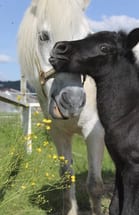Laminitis
 Laminitis, also known as founder, is a serious equine disease, a common cause of lameness in horses. The disorder affects the lamina of the horse's foot, the part that connects the protective outer layer of the hoof to the sensitive internal structures. Laminitis causes pain, inflammation, increased temperature in the hoof, and impaired mobility.
Laminitis, also known as founder, is a serious equine disease, a common cause of lameness in horses. The disorder affects the lamina of the horse's foot, the part that connects the protective outer layer of the hoof to the sensitive internal structures. Laminitis causes pain, inflammation, increased temperature in the hoof, and impaired mobility.
Risk Factors for Laminitis
While the precise causes of laminitis are unknown, several risk factors have been isolated, most of which can be avoided by careful horse management. These include:
- Overeating, especially of grain
- Obesity
- Infection, such as colic or pneumonia
- Bacterial, viral, plant, chemical or fungal toxicity
- Mechanical trauma, e.g. from jumping on hard surfaces
- Improper shoeing or foot dressing
- Bedding on black walnut shavings
- Extreme stress, such as involved in constant traveling
- Drinking an excess of cold water when overheated
The last item on the list is somewhat controversial, although it is generally agreed that horses prefer their water at about 50 degrees Fahrenheit and that is isn't a good idea to allow an overheated horse to consume more than a few sips of very cold water until it has cooled down.
Symptoms of Laminitis
Signs of pain are usually the first signs of laminitis. Although all four feet may be affected, since the front feet bear 50 percent more weight than the rear feet, they are typically more painful. Because of the pain experienced, the horse's stride shortens and its gait becomes slower and stiffer. A horse with laminitis is likely to shift its weight back and forth from one front leg to the other and to lean back on its rear legs to decrease weight-bearing on the front legs. As the situation exacerbates, the horse may spend more and more time lying down.
Upon examination, the affected hoof is typically swollen, warm, and tender to the touch. The horse may exhibit other symptoms of malaise and discomfort.
Diagnosis of Laminitis
 Any horse experiencing lameness or pain should be examined by a veterinarian. The following diagnostic tests will be taken:
Any horse experiencing lameness or pain should be examined by a veterinarian. The following diagnostic tests will be taken:
- Blood counts and tests for electrolyte levels
- Urinalysis
- X-rays
- MRIs, occasionally
Diagnostic imaging shows the degree of rotation of the toe bone within the hoof capsule that indicates the severity of damage. Although the foot feels warm to the touch, recent evidence demonstrates that platelets in the blood may form clots which are actually causing blood to flow away from the lamina, resulting in ischemia, which causes oxygen deprivation to the involved tissues. Recent studies have demonstrated an elevated blood protein level in horses with chronic laminitis, indicating that the disease may be more systemic than originally believed.
Treatment of Laminitis
There are several effective treatments for laminitis. Simple steps, like reducing stress and adding dietary supplements may be helpful in mild cases. In early stages of the disorder, muzzling the horse to keep it from overeating may be a good idea.
To relieve pain, encouraging (not forcing) the horse to walk on soft ground and administrating aspirin are good stopgap measures until a veterinarian can be contacted. Any further treatment, however, should always be administered under the supervision of a qualified veterinarian.
Treatments for laminitis include:
- Treating underlying infections with antibiotics, antifungals or other medications
- Administration of NSAIDs, typically phyenylbutazone (bute), to relieve pain
- Reshoeing, taping, or elevating heels to offer support and relieve pressure
- Soaking the feet in cold or warm water, though this method is controversial
- Placing the horse in a stall or paddock with very soft bedding
- Administration of mineral oil and injectable Banamine if overfeeding is involved
- Low dose of medication to increase blood flow.
In severe cases of laminitis, bute may be administered intravenously and mineral oil and Banamine may be inserted through a stomach tube. In some situations, a surgical procedure known as deep digital flexor tendon (DDFT), in which the affected tendon is released, is recommended.
If the horse's pain remains unrelieved, the possibility of a sole abscess should be considered. This may occur in only one foot at first, but quickly progress to the other foot. If abscesses occur as secondary infections in a horse with founder, they require opening, draining and cleaning with antiseptics.
Unfortunately, in some cases, founder becomes chronic and the horse remains in constant pain. In such instances, euthanasia must be considered.
